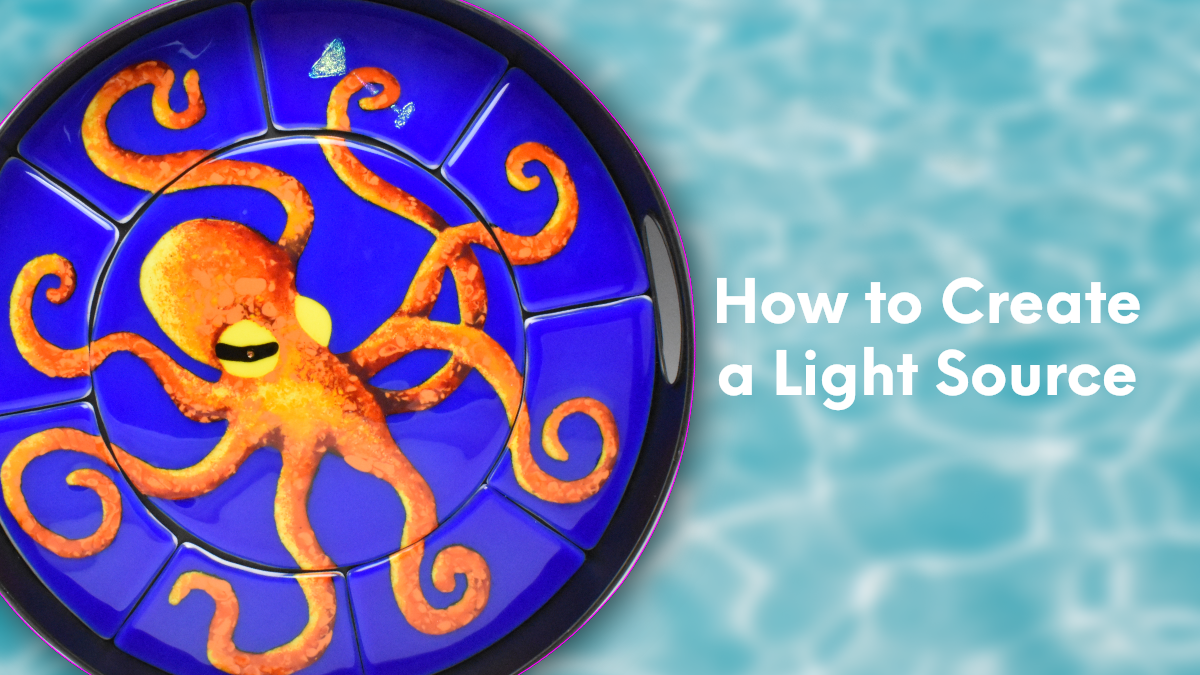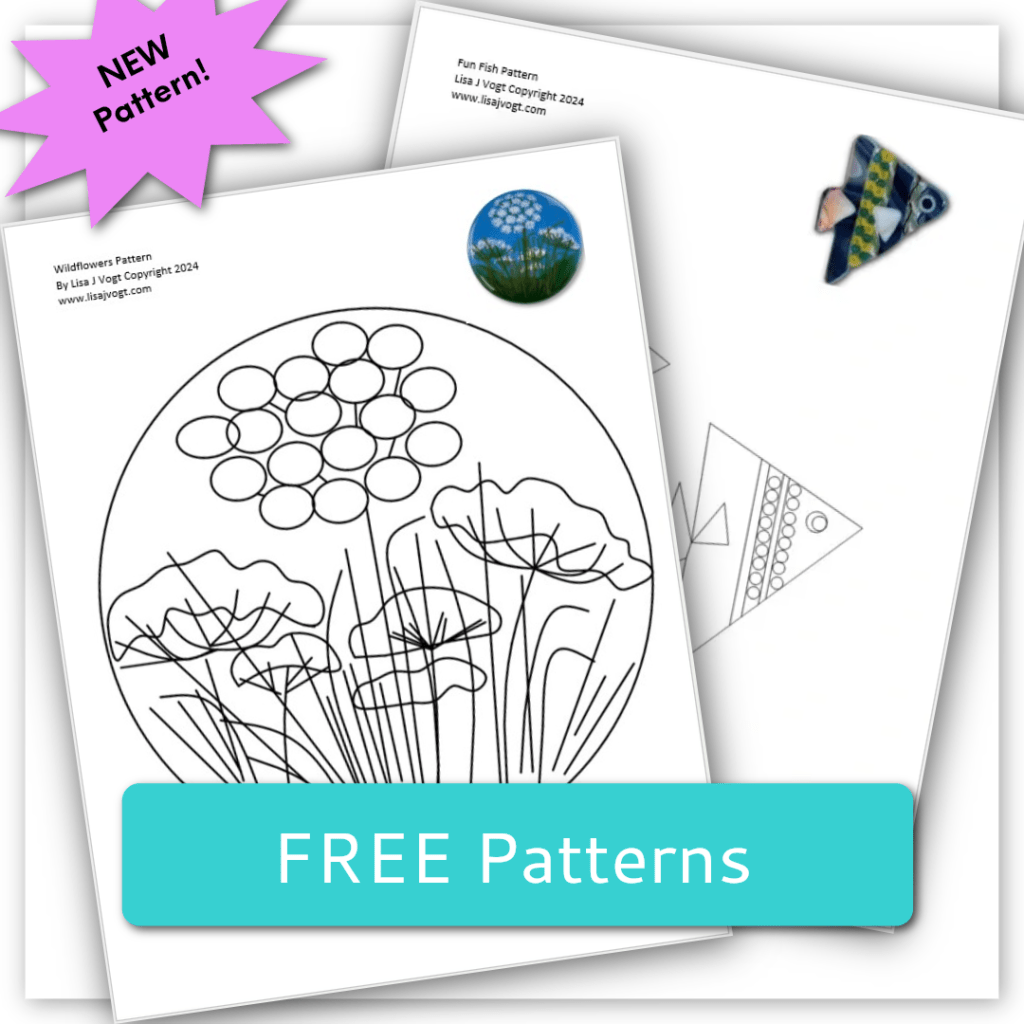
You may know, I studied fine art in college. Art classes were the only classes I excelled in and so I filled my schedule with everything from art history to weaving. Art history was an 8:00 am class I slept through more than I should have. While my oil painting class in the afternoon always had my full attention. To this day, I love the smell of paint and the limitless possibilities of a dripping brush in my hand.
Now, I apply the art theory principles I learned all those years ago in my painting class to the development of my fused glass artwork.

You can too! It’s easy.
You just have to put purposeful thought into how you approach your glass work.
There are several design tips I consider using when I start a project. Creating a light source is ideal for patterns with realistic subject matter like this octopus. As you can see, the addition of highlights and dark shadows opposite them really bring this exotic ocean dweller to life. So, how do you achieve this level of sophistication?

One step at a time.
Frit is an amazing tool for glass artists who want to give their pieces gradual color changes that produce one-of-a-kind designs with a painterly quality.
I drew this octopus design for a large mosaic project. It turned out beautifully. The stretching image was so powerful I knew I had to find another use for this whimsical pattern.
This specific design is also a great example of how easily you can repurpose a pattern. You can make the pattern smaller and use a different glass assembly technique to get further enjoyment out of a favorite design.
At first glance, this design looks busy and difficult to make. But if you break down the stages into steps, the creative process is manageable and even fun.
When deciding exactly how to build this design, it made sense to cut the blue background out of sheet glass. This would give the design a pleasing solid field of color that would enhance the fluid movement of my focal point, the octopus.
It would have been time consuming and difficult to cut sheet glass for the octopus tentacles and body. I decided the fastest, easiest, and most visually exciting way to render these areas would be with the application of frit. With frit I could create shading and visual texture that would beautifully contrast and pop out from the sharp confines of the blue water background.
This piece is made using two layers of fusible glass. The base layer is white. I cut the second, blue glass layer with a wet saw. The cut blue layer is then stacked on the white base layer and held in place with a small amount of fuser’s glue. Once dry, the glue prevents the blue glass pieces from moving. This is an important step as it ensures you have clean edges and strong line quality around the octopus body and tentacles.

Applying the frit.
My daughter did a fabulous job applying the frit. We started with a course orange opal frit on the right side of the octopus’s body and tentacles. Moving to the left, we gradually added a fine orange opal followed by a fine marigold yellow opal frit. We then added fine bright yellow opal, concentrating it on the left side of the tentacles and the upper left side of the octopus’s head. This bright yellow established the direction of the light source in the upper left hand corner of the design. The use of different shades of color and different frit sizes increases the visual depth and fullness of this design.

Now for the shadows.
Highlights like these are stronger and more effective when contrasted by deep shadows. We applied fine dark red opal frit on the right side of the tentacles and where the tentacles join the body. Fine purple frit was used to create darker shadows where the tentacles overlap and where they disappear behind the octopus’s body.

This artwork was full fused. The completed piece was glued into a 15 inch metal serving tray. This pattern can easily be made smaller, and you will have the same great results.

Tips for working with frit.
Apply larger size frit first then fill in the gaps with smaller frit of different color.
Start with a small amount of frit. You can always add more as needed.
Apply the frit with purpose. Plan your direction and the way the colors will transition from one to another.
Create color gradients using different shades of the same color frit.
Blend colors for added interest.
Don’t be skimpy. Apply a thick layer of frit to hide the white glass base layer below.
Take your time and enjoy watching your colorful design develop.
Be bold. Have fun!
You got this!
I hope this artistic insight empowers you to work with frit and create striking original pieces of art.
For more tips watch my, How to Design with Purpose Video.
For more design tips PL US 12 brilliant projects check out my Fused Art Design video!
Follow my blog for weekly inspiration sent to your inbox!
Happy Fusing!
Lisa
Upcoming Class!
Advanced Glass Fusing Class
4-Day, Hands-on Class, Wesley Chapel, FL
October 22-25, 2024, only 1 Seat Left.
YOU can make gallery quality fused glass art! You’ll love the personalized instruction in this exciting advanced technique, artistic awakening and skill building workshop. This is the turning point experience you’ve been waiting for.
Someday is here! What are you waiting for? You’re in your prime. You’re at the peak of your interest in glass fusing. Take the next step and raise your artwork to an exciting new level of sophistication.
Join me for this intense workshop held in my private studio.
Wesley Chapel, Florida, 4-Day, Hands-on, Class size is limited.
In this class, you will push the boundaries art glass imposes. Students will explore innovative approaches to design and combine multiple advanced techniques to construct original art that reflects their own personal style. You’ll enjoy: the one-on-one instruction, making multifaceted projects, the well-equipped classroom, and the intimate class size.
You’ll love the concentrated, in-depth study and creative momentum you’ll gain while actively producing, nonstop for four consecutive days. You’ll leave class with a working knowledge of kiln operation, custom project specific firing guides, and the inspiration you’ve been craving to go bigger and do more elaborate works of fused glass art!
Join me and take your glass fusing to the next level!








































































































